| |
|
By Jackie Rosselli |
|
 What’s in a name? Plenty, it turns out. In a move to broaden the scope and number of submissions of its popular best-dressed police department competition, the North-American Association of Uniform Manufacturers and Distributors, who itself underwent a moniker makeover two years ago, rechristened its annual contest the Best Dressed Public Safety Awards. What’s in a name? Plenty, it turns out. In a move to broaden the scope and number of submissions of its popular best-dressed police department competition, the North-American Association of Uniform Manufacturers and Distributors, who itself underwent a moniker makeover two years ago, rechristened its annual contest the Best Dressed Public Safety Awards.
There were other important changes as well. Previously open to U.S. agencies only, departments from across North America were invited to participate in this year’s program. In another first, categories were expanded to include fire and other first-responder public safety programs. “There are many who serve and protect the public, and the new format was designed to recognize and congratulate these agencies and the suppliers who designed their uniform programs,” says Richard J. Lerman, NAUMD president.
Winners of the first-ever Public Safety Awards competition were announced in April during a special presentation in Las Vegas. Winners were selected in eight categories ranging from small city police departments to large special agencies. Winning programs were selected by an independent panel of judges including public safety officials, representatives from the media and public safety educational institutions.
The honorees are featured below. To learn more about the contest, visit www.naumd.com.
|
|
| |
|
In a year when the contest itself received an overhaul, what better time to turn the spotlight on a department that accomplished the same thing?
For Rapides Parish Sheriff’s Office in Louisiana, winning top honors as a county department is somewhat of a misnomer. In Louisiana, these political subdivisions are referred to as parishes, a distinction unique to the region.
The state’s police uniforms, however, were anything but distinct. “Historically, Louisiana departments wore the same thing,” explains Brent Caplan of Caplan’s Inc., the Alexandria, La.-based dealer who supplied the best-dressed program. “There was little interest in standing out or in a look that was more individualized, and Rapides Parish followed the model.”
Caplan should know; the sheriff’s office has been a customer for more than four decades. But the tradition started to change in the 1980s, when the wife of then-Sheriff Kelly designed new garments colored in what became known as Kelly Green. “It was actually a spruce green, but the sheriff liked the reference,” notes Caplan. Sheriff Kelly’s chief deputy eventually took charge but did little than minor modifications to the overall look.
The real transformation didn’t occur until July 2008, when Charles “Chuck” Wagner Jr. formally took the reigns as sheriff. Elected the previous November, Sheriff Wagner used the interim period to survey his deputies and review a number of different uniform options. “We worked closely with the sheriff and his team prior to the rollout to determine which of the latest product offerings from our various suppliers would work in this new program,” says Caplan.
The sheriff quickly decided to institute change department wide, ordering new uniforms, vehicles and other items to distinguish his agency. “He wanted to boost morale, and this was one way to accomplish it,” continues Caplan.
After narrowing the possibilities to three, the department’s 480 uniformed personnel finally settled on a navy and silver tan color scheme. Its basic look, the Class A, uses a 100 percent polyester fabric that is washable for easy care. “It’s the same weight and fabric as they had before, but because the colors are lighter, the uniform is perceived as cooler and more comfortable,” says Caplan.
Rapides Parish Deputies wear a plain navy pant accompanied by a silver tan shirt affixed with cordedge braid. A redesigned shoulder emblem appears on the right arm and is approximately 30 percent larger than standard.
For the Class B uniform, which is worn by correctional officers, the same color scheme is used, but the formal look of a Class A is replaced with the more appropriate BDU.
While morale played a role in the adoption of the new program, so did the realities of an increasingly dangerous world. Concern over a spate of police impersonations was the catalyst behind a major change the design of a new badge. Caplan says, “The Sheriff was concerned that the previous badge may have, over the years, fallen into unqualified hands, so he wanted a new one to differentiate from the previous administration. In addition, new controls and procedures were implemented to monitor and better track employee purchases of uniforms, equipment and accessories.”
Supplied by V.H. Blackinton, the five-point star badge is embellished with the State of Louisiana seal and identifies the holder as a member of the department. The design was also incorporated into the oversized emblem, providing a consistent appearance for all deputies.
Not in use at the time of the competition, the RPSO program also calls for a straw or felt campaign hat, although the headwear was being worn by members of the Youth Academy. Other specialized units include Communications Officers, who don 5.11 Tactical polos and special ops pants by The Force, and a K-9 Unit that wears uniforms manufactured by Blauer.
“The program fits nicely with the sheriff’s goal of creating a revamped public image as well as a clear visual delineation for the various divisions within the department,” says Caplan. “Its success is directly related to the sheriff’s involvement and Caplan’s experience in putting customers in clothing that works.”
|
|
| |
|
Class A uniforms and campaign hats are considered normal dress for many police departments, but for jails? “No, the look isn’t common in this area or in other regions of the country,” says Larry Powers, director of the Spartanburg County Detention Facility in South Carolina. “But it sets the tone for what’s expected of our officers.”
What’s expected at this pre-trial holding facility is adherence to strict professional standards, and proper attire is considered an important ingredient. “Image matters,” Powers says. “It helps maintain order and instill public confidence.”
When Powers took command in 1982, officers wore a more expensive wool uniform, but the high price tag didn’t translate into a better look. Dissatisfied, Powers consulted with several uniform suppliers, finally settling on a program in 1984. Many of the changes are still in existence today.
Officers sport navy blue pants and jackets as well as light blue shirts, and each must wear a tie, although female officers have two options from which to choose. No jewelry may be worn, and with the exception of clear, no nail polish. Wool has been replaced by a more popular and practical poly blend. The aforementioned campaign hats, manufactured by Stratton, are expected to be worn at all times once an officer leaves his car. The department also has specialized wear, including a dress and honor guard uniform.
The facility has 189 employees, and each, including clerical, food services and nurses, wears some type of uniform. Even non-sworn personnel are expected to adhere to the department’s high standards, as is evidenced by the simple, solid colored scrubs worn by nurses. “You won’t find any loud or crazy prints here,” notes Powers.
|
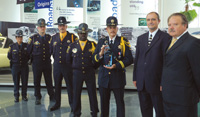
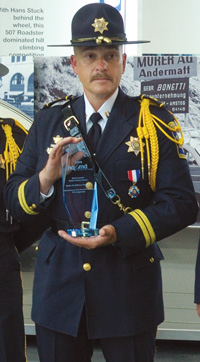
|
|
| |
|
When the Abington, Pa., Police Department decided to change its uniform program four years ago, the motivation behind the decision was more than the desire for a new look. Certainly, it wanted an updated appearance, but the department was equally concerned with fit and continuity problems it had with its previous uniform.
“They used to wear a powder blue shirt, and if you lined up four officers, each had a different shade of blue,” says Michael Bucks of Red the Uniform Tailor (RTUT), the department’s current supplier. “Part of the problem was fabric selection; part was due to vague specifications.”
RTUT quickly stepped in, reviewing area departments to assure that a new program would complement, not copy, what was expected in the region. Made-to-measure garments replaced the previous off-the-rack wear, and Abington’s patches, emblems and chevrons were redesigned.
The resulting Class A look is both sharp and practical for this suburban Philadelphia department. Officers now wear an Air Force blue 55/45 poly/wool shirt available in two options: an 8.5-oz. short sleeve, or an 11-oz. long sleeve. Trousers, offered in a tropical, serge and winter weight, are striped in Air Force blue. Ties or turtlenecks are worn depending on the preference of the wearer. A Pershing hat with crown piping completes the everyday appearance.
There are uniforms for specialized units as well, including a Class C K-9 outfit. Here, RTUT used cloth patches on shirts and affixed an Air Force blue stripe on a poly/cotton cargo trouser. The dressed down and practical outfit perfectly coordinates with the department’s standard look.
|
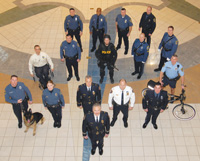
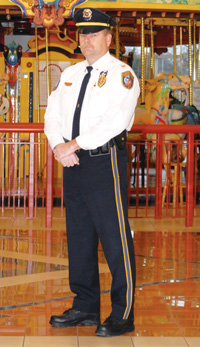

|
|
| |
|
A two-time best dressed winner, the Washington State Patrol has come a long way since its establishment in 1921, when the only items issued were a badge, cap emblem and gun. What distinguishes a WSP trooper today is the campaign hat and bow tie. First introduced in 1937, the black bow tie has remained a constant when wearing the winter or formal uniform, which consists of a long-sleeve blue shirt with dark blue pocket flaps, French blue pants striped with dark blue, and a felt royal blue campaign hat. This uniform may be worn with the traditional bow tie or open collar with a dark blue dickie.
In summer, troopers wear issued pants, short-sleeve shirt, white round-neck T-shirt, and straw or felt campaign hat. Officers do have the option of wearing the summer uniform year round; however the straw campaign hat may only be worn from April 1 to October 31 each year. Troopers and sergeants wear a silver badge and hat braid, while lieutenants and above ranks wear a gold badge and hat braid.
Specialized uniforms are issued to motorcycle officers, bicycle and canine units, and the Special Weapons and Tactics team. Of all the specialized wear, however, it is the Honor Guard that is truly a standout. The military-style tunic of this uniform exhibits the traditional colors of the department with a gold outline to the dark blue accents of the shirt and trousers. Gold accessories, white cord, a belt and gloves complete this striking look.
While the department is rooted in the past, its eyes are clearly on the future. “They want a traditional appearance, but they are also eager to take advantage of the latest in trimmings and design,” said Blumenthal Uniforms’ Roger Heldman when the department won in 2007. “As an independent dealer, we’re able to show them all available options, and to provide the customization they seek.” As examples, Blumenthal provides the department with up-to-date pocketing on trousers and stretch collars that offer comfort without compromising appearance.
|
|
| |
|
The term “Red Legs” may not sound like one of respect, but to troopers in Mississippi, the words are worn like a badge of honor.
According to Wikipedia, the phrase came into vogue in the 1960s, when the Mississippi Highway Patrol switched the pant piping for all troopers holding the rank of Captain and below from gold to red. This led to the nickname “Red Leg,” signifying that they are not upper echelon administrative employees but rather “Road Men,” troopers who worked enforcement on the highways. The name stuck and is still in use today.
So proud is Mississippi of its law enforcement officers that the state legislature has consistently passed bills making it illegal for any non-Mississippi Highway patrol officer to wear the outfit. And when learning of their first-place finish in the state category of the best dressed competition (tied with Washington Highway Patrol), Col. Mike Berthay and Troopers Charles Haynes and Luke Harrington traveled to Las Vegas to accept the award on behalf of the entire sworn division of the Mississippi Highway Patrol, proudly wearing Class A, Class B and Honor Guard uniforms.
“Thanks to all Mississippi Troopers who wear the blue and gray uniform that represents our state and provide protection and public safety to our citizens,” said Berthay. “You each can take pride in knowing that you are not only the best at what you do, you are also the best dressed.”
The Mississippi Highway Patrol was created in 1938, with troopers first patrolling the highways on motorcycles. The original uniform consisted of a gray shirt with navy blue epaulettes trimmed with gold. The shirt had an MHP patch on each arm, which was very similar to the patch worn today, except in blue and gold instead of blue and red. The pants were blue with a darker navy blue stripe down the leg bordered by gold piping.
The department’s current Class A uniform consists of French blue trousers with the infamous red stripe running down the leg, navy Eisenhower jacket, long-sleeve gray shirt and blue tie. The shirts, a 55/45 poly/wool blend, are made in the United States. “I can’t say for sure if Made in the USA ensures a better look,” says Ed Straight of Southeastern Shirt Corporation. “But it does provide much more control over the manufacturing of a product and service level to the customer.” In business for more than 28 years, Southeastern is a Made in USA manufacturer of shirts and trousers for uniformed professionals.
There are also other uniforms in the MHP catalog. The Class B utilizes the same French blue pants and gray shirts, but the outfit is worn with a short-sleeve shirt in summer sans tie. Specialized wear includes a long navy dress jacket for the Honor Guard, an all-black uniform for the Special Ops Unit, and K-9 and SWAT uniforms.
“The men and women of the highway patrol know that looking professional on the job is key to earning the respect of citizens,” said Berthay.
|
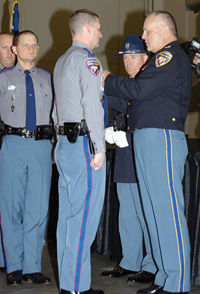
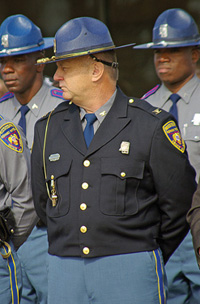
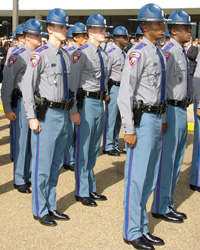
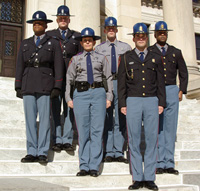
|
|
| |
|
Located in Worcester County, Mass., Sturbridge is well known for its deep, rich American heritage. Sites such as the Old Sturbridge Village living history museum, which recreates life in rural New England during the 1830s, and Tantiusques, an open space reservation notable for its defunct graphite mines, make it a popular year-round tourist destination.
Increased public interaction with law enforcement is inevitable, given the area’s high-profile status. It is therefore important that officers be professional in demeanor and in appearance too. Their uniform provider has clearly helped accomplish the latter.
As is the case with many departments, an installment of a new chief often translates into a new uniform program, and the Sturbridge Police Department is no exception. The chief wanted an updated look for his 30-member department, but he didn’t want to stray too far from what had become a highly recognized outfit. Using the familiar color palette of gray, black and red, the new uniforms include a banker’s gray, three-ply tropical shirt and black trousers striped with gray. A red braid appears in the center of the stripe. Hats, manufactured by Keystone, are in a crushed, Massachusetts style.
The made-to-measure uniforms are constructed of a 55/45 poly/wool blend. The department has been a RTUT customer since 2002.
|
|
| |
|
In a competition that celebrates the importance of uniforms, it makes sense to develop a category devoted to this cause. It is also appropriate for one of the country’s newer law enforcement agencies to be the recipient.
The Lone Tree Police Department is the newest police department in the State of Colorado, and it is also the winner of the NAUMD’s first-ever Most Innovative Product award. The City of Lone Tree first thought of having a police department in the spring of 2004. It all came together when the city hired its top cop, Chief Steven Hasler, in August 2004.
Hasler immediately hired six officers from other law enforcement agencies within the metro area to assist with the initial startup and later expanded the total to 22 men and women. They were given the arduous task of building a police department from the ground up in three months.
The official swearing-in ceremony took place Dec. 13, 2004, with the officers officially taking to the streets Jan. 1, 2005. Not since 1984 has a new police department started within the State of Colorado.
One of Chief Hasler’s first tasks was to create a uniform program that represented the department’s unique nature and responsibilities. Items of course had to look good, but they also needed to be appropriate for the type of work performed. Further, they needed to address the peculiarities of the state’s weather, which includes harsh and unforgiving winters.
Enter the department’s winning product, the one-piece Inclement Weather Uniform (IWU) made by Walpro and distributed by Quartermaster Uniforms. When the IWU is paired with the versatile H3 Hummer, Lone Tree Police Officers are able to respond to any type of situation regardless of the weather conditions.
The importance of this uniform cannot be overstated. During a severe snowstorm last year, officers responded to the homes of nurses and doctors who could not make it to work and transported them to the hospital, enabling these dedicated professionals to save lives. And the department was one of the first agencies to respond to several plane crashes, thanks to the IWU and H3 Hummer.
While proud of these accomplishments, they are equally pleased with the remaining items in their program. Every uniform includes perfectly matching patches, service stripes and rank symbols. The patches and badges, which were specifically designed for the department, incorporate the signature gold and green colors of the City of Lone Tree. Officers adhere to a strict uniform policy, and the department provides several sets of complete uniforms for each officer, paying a cleaning allowance to cover the cost of dry cleaning and allowing officers to replace damaged uniforms with a generous “wear and tear” policy.
|
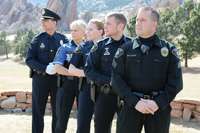
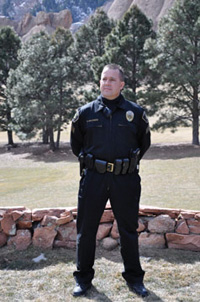
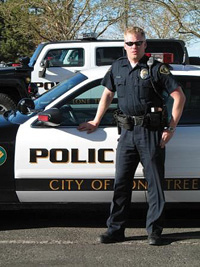
|
|
| |
|
What better way to promote the use of uniforms than by bringing the concept to the next generation of potential wearers?
That’s exactly what the NAUMD had in mind when it created the Best Dressed Organization category, and named this Long Island, N.Y., group of youth law enforcement prospects its first winner.
Under the auspices of the Nassau County Police Department, the Explorers Squad seeks to encourage young high school volunteers to someday enter the law enforcement profession. The new uniform program helps empower the squad by giving them a well-designed, professional uniform. “Many of these kids go on to become police officers,” says Steve Robinson, Liberty Uniforms co-owner.
The easy care and completely washable uniforms are manufactured from 100 percent polyester. Trousers are colored in navy, and shirts are light blue. Patches serve to identify participants as members of the squad: one is affixed to each sleeve and a third appears on the chest pocket.
|
|
| |